Beneficial
none known
Family: Scarabaeidae Subfamily: Scarabaeinae Genus: Onthophagus Species: Onthophagus tuberculifrons Harold, 1873
none available
Total body length 3.5–5.0 mm (0.13–0.20 in). Body shape oval; may be caked in dung. Color dull black, sometimes with orange spots on abdomen. Size tiny, under 6 mm. Sexes noticeably dimorphicdimorphic:
occuring in two distinct forms
. Clypealclypeal:
of, or referring to, the clypeus
apexapex:
point or edge furthest from the body
broadly emarginateemarginate:
notched or with a rounded section removed from the margin, often applied to the anterior margin of the clypeus
in male; bifurcatebifurcate:
a process dividing into two points
in female. Head with 2 weak tubercles in both sexes. Ocular canthuscanthus:
a process extending over and sometimes dividing the eye
not completely dividing eye. Scutellumscutellum:
the triangular portion of the thorax between the bases of the elytra
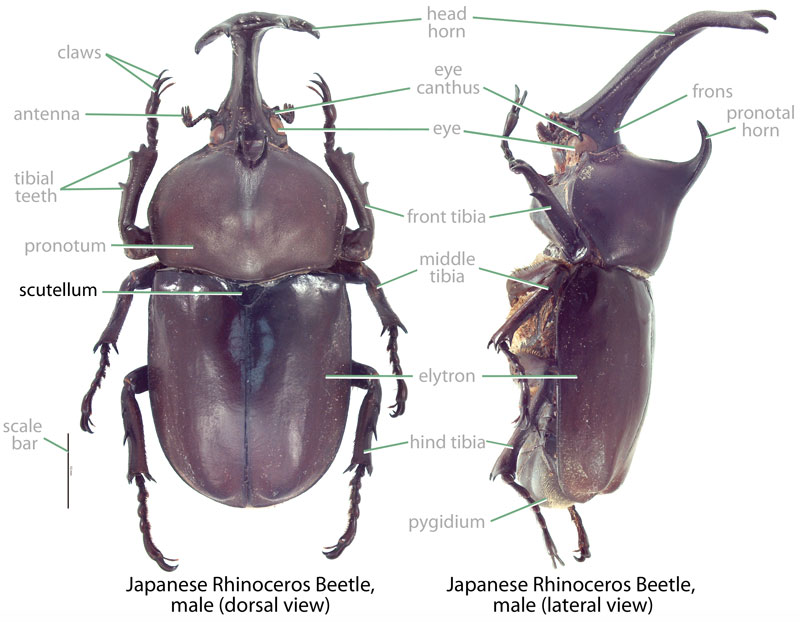 absent.
absent.
(Brach, 1977Brach, 1977:
Brach V. 1977. Larvae of Onthophagus polyphemi polyphemi and Onthophagus tuberculifrons Coleoptera Scarabaeidae. Bulletin Southern California Academy of Sciences 76: 66-68.): Grub C-shaped, hump-backed, cylindrical, and cream-colored. Maxillamaxilla:
set of paired mouthparts located posterior to the mandibles
with galeagalea:
outer branch or lobe of the maxilla
 and lacinialacinia:
and lacinialacinia:
inner portion of the maxilla distinctly separate. Mandiblemandible:
distinctly separate. Mandiblemandible:
The crushing or chewing portion of an insects mouthparts
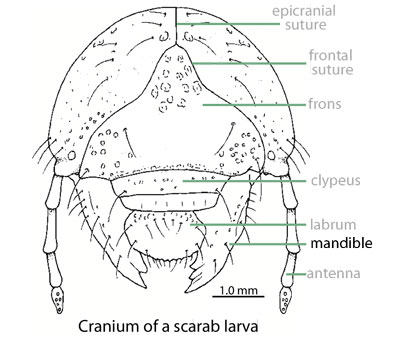 maxillary stridulatory area with a row of 5–7 short, conical teeth. Epicranial stemepicranial stem:
maxillary stridulatory area with a row of 5–7 short, conical teeth. Epicranial stemepicranial stem:
in scarab larvae, the stem of the epicranial suture dividing the top of the head
deeply forked basally on fronsfrons:
part of the head generally positioned between the eyes (posterior to the clypeus and anterior to the vertex) and visible dorsally
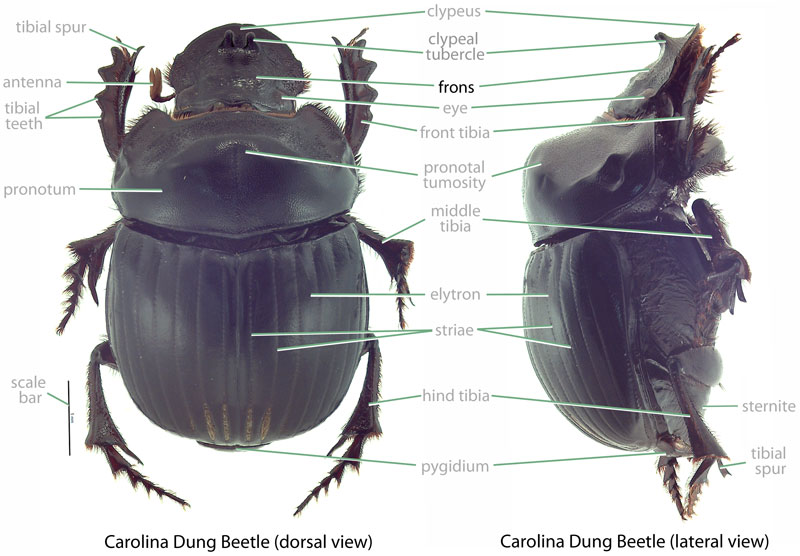 . Epipharynxepipharynx:
. Epipharynxepipharynx:
lobe on the interior surface of the labrum or clypeus
with tormaetormae:
in scarab larvae, sclerotized structures on the ends of the clypeolateral suture extending towards the mesal line
united mesallymesally:
at or near midline of body
. Epipharyngeal phobaphoba:
in scarab larvae, an area of dense, often forked setae at the posterior inner edge of the paria
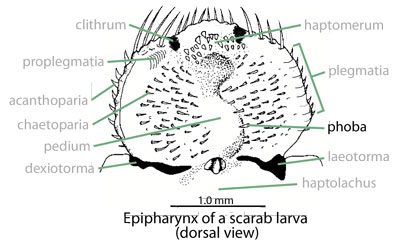 with teeth small and conical. setaesetae:
with teeth small and conical. setaesetae:
small, hair-like structure
.-segmented, distaldistal:
situated away from the point of articulation, thus usually furthest from the body
segment much reduced. Legs 2-segmented. Prothoracic shieldprothoracic shield:
the chitinous plate behind the head of larvae
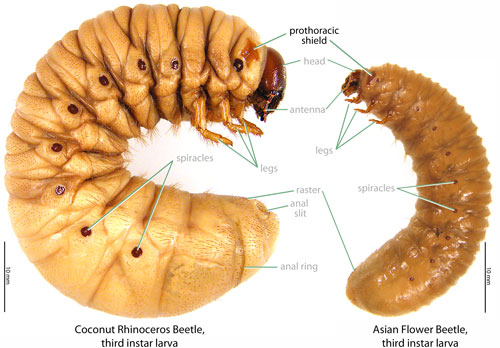 without anteriorly projecting processes. Third abdominal segment bearing a prominent conical, dorsaldorsal:
without anteriorly projecting processes. Third abdominal segment bearing a prominent conical, dorsaldorsal:
of or relating to the upper surface; opposite of ventral
gibbosity with two patches of 45–52 weakly curved to straight, finely-pointed setaesetae:
small, hair-like structure
. Venter of last abdominal segment with two sparsely-set, irregular patches of 30–39 caudally oriented setaesetae:
small, hair-like structure
.
Eastern U.S. This species is native to the U.S. where it is found from eastern Texas and Kansas north to Wisconsin and eastward to Connecticut and southern Florida (Woodruff, 1973Woodruff, 1973:
Woodruff R. 1973. The scarab beetles of Florida (Coleoptera: Scarabaeidae) part I. The Laparosticti (Subfamilies: Scarabaeinae, Aphodiinae, Hybosorinae, Ochodaeinae, Geotrupinae, Acanthocerinae). Arthropods of Florida and Neighboring Land Areas 8: 1-220.).
None. This species feeds on dung as both an adult and larvalarva:
the immature form of an insect; in scarabs, also called grub or white grub; preceded by the egg stage, followed by the pupal stage
 . There are no records of this scarab feeding on live plant tissues, although adults will consume rotting vegetation (Woodruff, 1973Woodruff, 1973:
. There are no records of this scarab feeding on live plant tissues, although adults will consume rotting vegetation (Woodruff, 1973Woodruff, 1973:
Woodruff R. 1973. The scarab beetles of Florida (Coleoptera: Scarabaeidae) part I. The Laparosticti (Subfamilies: Scarabaeinae, Aphodiinae, Hybosorinae, Ochodaeinae, Geotrupinae, Acanthocerinae). Arthropods of Florida and Neighboring Land Areas 8: 1-220.).
(Woodruff, 1973Woodruff, 1973:
Woodruff R. 1973. The scarab beetles of Florida (Coleoptera: Scarabaeidae) part I. The Laparosticti (Subfamilies: Scarabaeinae, Aphodiinae, Hybosorinae, Ochodaeinae, Geotrupinae, Acanthocerinae). Arthropods of Florida and Neighboring Land Areas 8: 1-220.): This species is often associated with sandy habitats where adults feed on dung, rotting vegetation, carrion, and fungus. In South Carolina, adults are active throughout the year (Bertone, 2004Bertone, 2004:
Bertone M. 2004. Dung beetles (Coleoptera: Scarabaeidae and Geotrupidae) of North Carolina cattle pastures and their implications for pasture improvement. MS thesis, University of North Carolina State University. full text (accessed 2015)). Life history is poorly known, but related Onthophagus species are dung tunnelers, and females create burrows under or near a dung source. The burrow is then provisioned with dung in the form of brood balls. Each ball is impregnated with an egg; larval development occurs within the brood ball.
None. This species recycles dung and is beneficial for ranching and farming in Hawaii. Primarily being a dung feeder, this species has never been recorded damaging crop or ornamental plants. Additionally, this species is not a threat to native dung beetles because none occur in Hawaii or Guam.
Established. In Hawaii, this species was imported to combat the horn fly (Haematobia irritans), a biting pest of livestock. Specimens were released in 1963 at Ewa and Kailua on Oahu (Davis and Krauss, 1964Davis and Krauss, 1964:
Davis C and Krauss N. 1964. Recent introductions for biological control in Hawaii—IX. Proceedings of the Hawaiian Entomological Society 18:391-398. full text , DOI (accessed 2015)).
Not established or recorded. There are no records of this species from Guam.
In Hawaii, this species was intentionally imported.
This tiny scarab is extremely similar to the closely related Onthophagus oklahomensis and superficially similar to small specimens of Leconte's dung beetle (Ateuchus lecontei). These three species are separated by examining the clypealclypeal:
of, or referring to, the clypeus
apexapex:
point or edge furthest from the body
(O. tuberculifrons with an emarginateemarginate:
notched or with a rounded section removed from the margin, often applied to the anterior margin of the clypeus
or bidentatebidentate:
a surface that is sharply notched, usually resulting in two tooth-like protrusions on each side of the notch
clypeus versus O. oklahomensis with an entirely rounded clypeusclypeus:
part of the head anterior to the frons; the most anterior portion in dorsal view
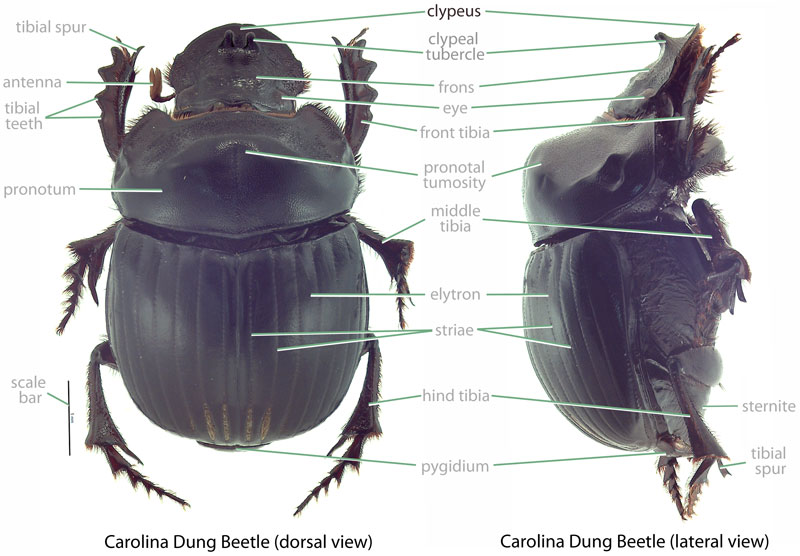 ) and tubercles of the head (O. tuberculifrons with pairedpaired:
) and tubercles of the head (O. tuberculifrons with pairedpaired:
in relation to bilateral symmetry: occurring on both sides of the body
tubercles versus O. oklahomensis and A. lecontei lacking tubercles).
Onthophagus tuberculifrons Sturm (nomen nudum), Onthophagus tuberculatus Gemminger and Harold (nomen nudum)
Report your observation of this beneficial species at our iNaturalist project.